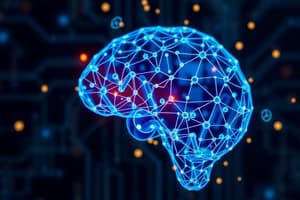Podcast
Questions and Answers
What characteristic determines if a problem can be broken down into smaller, more manageable parts?
What characteristic determines if a problem can be broken down into smaller, more manageable parts?
- Requirement of absolute knowledge
- Decomposability of the problem (correct)
- Existence of a clear solution
- Predictability of the problem's universe
In which type of problem can solution steps be ignored without affecting the overall solution?
In which type of problem can solution steps be ignored without affecting the overall solution?
- Irreversible problem
- Ignorable problem (correct)
- Dependent problem
- Recoverable problem
What is a key distinguishing feature of a recoverable problem?
What is a key distinguishing feature of a recoverable problem?
- The solution is always predictable
- Solution steps can be undone if they were ineffective (correct)
- Knowledge is not needed to continue solving it
- It contains independent sub-problems
Which example illustrates a decomposable problem?
Which example illustrates a decomposable problem?
In what scenario is a problem considered to have a predictable universe?
In what scenario is a problem considered to have a predictable universe?
Which of the following best describes the Block World Problem?
Which of the following best describes the Block World Problem?
What is the primary concern when a problem requires interaction between a computer and a person?
What is the primary concern when a problem requires interaction between a computer and a person?
What type of problems require significant knowledge only for specific stages of the search process?
What type of problems require significant knowledge only for specific stages of the search process?
What characterizes an irrecoverable problem?
What characterizes an irrecoverable problem?
Which example represents a recoverable problem?
Which example represents a recoverable problem?
In what type of problem can solution steps be ignored without consequence?
In what type of problem can solution steps be ignored without consequence?
What does a certain-outcome problem allow for in terms of planning moves?
What does a certain-outcome problem allow for in terms of planning moves?
Which type of problem is illustrated by playing Bridge?
Which type of problem is illustrated by playing Bridge?
What is a key factor in an any-path problem?
What is a key factor in an any-path problem?
What strategy is necessary for solving recoverable problems?
What strategy is necessary for solving recoverable problems?
What kind of moves are possible in an uncertain-outcome problem?
What kind of moves are possible in an uncertain-outcome problem?
What year did Marcus die?
What year did Marcus die?
How old would Marcus be in 1991 AD if he were alive?
How old would Marcus be in 1991 AD if he were alive?
Which axiom establishes that all men are mortal?
Which axiom establishes that all men are mortal?
What is the maximum age a mortal can live according to the content?
What is the maximum age a mortal can live according to the content?
Which statement is logically deduced from the information provided?
Which statement is logically deduced from the information provided?
What makes best-path problems computationally difficult compared to any-path problems?
What makes best-path problems computationally difficult compared to any-path problems?
Which axiom establishes the current year in the context given?
Which axiom establishes the current year in the context given?
What conclusion can be drawn regarding the certainty of Marcus's status?
What conclusion can be drawn regarding the certainty of Marcus's status?
What is the nature of a solution in the context of true best-path problems?
What is the nature of a solution in the context of true best-path problems?
How is knowledge important in problem-solving according to the content?
How is knowledge important in problem-solving according to the content?
Which of the following describes a solitary task?
Which of the following describes a solitary task?
What is necessary for a perfect program in chess, if computing power is not an issue?
What is necessary for a perfect program in chess, if computing power is not an issue?
In natural language understanding, what must be produced to solve the problem?
In natural language understanding, what must be produced to solve the problem?
What type of interaction is typical in theorem proving?
What type of interaction is typical in theorem proving?
Which statement is true regarding the information required for evaluating political news?
Which statement is true regarding the information required for evaluating political news?
What is a key characteristic of exhaustive search in true best-path problems?
What is a key characteristic of exhaustive search in true best-path problems?
What characterizes a monotonic production system?
What characterizes a monotonic production system?
What type of production system guarantees that any sequence of rules can be transformed by permutation while resulting in the same state transformation?
What type of production system guarantees that any sequence of rules can be transformed by permutation while resulting in the same state transformation?
Which production system type is least likely to be practically useful?
Which production system type is least likely to be practically useful?
What can be inferred about the relationship between problem types and production systems?
What can be inferred about the relationship between problem types and production systems?
In the context of production systems, what does the term 'partially commutative' imply?
In the context of production systems, what does the term 'partially commutative' imply?
Flashcards
Decomposable Problem
Decomposable Problem
A problem that can be broken down into smaller, independent sub-problems.
Non-Decomposable Problem
Non-Decomposable Problem
A problem that cannot be broken down into smaller, independent sub-problems.
Ignorable Solution Steps
Ignorable Solution Steps
Solution steps that can be skipped or reversed without irreparably hindering progress in the problem-solving process.
Recoverable Solution Steps
Recoverable Solution Steps
Signup and view all the flashcards
Problem Predictability
Problem Predictability
Signup and view all the flashcards
Problem Solvability with Computer
Problem Solvability with Computer
Signup and view all the flashcards
Prior Knowledge Necessity
Prior Knowledge Necessity
Signup and view all the flashcards
Solution State vs Solution Path
Solution State vs Solution Path
Signup and view all the flashcards
Recoverable Problems
Recoverable Problems
Signup and view all the flashcards
Irrecoverable Problems
Irrecoverable Problems
Signup and view all the flashcards
Ignorable Problems
Ignorable Problems
Signup and view all the flashcards
Certain-outcome problem
Certain-outcome problem
Signup and view all the flashcards
Uncertain-outcome problem
Uncertain-outcome problem
Signup and view all the flashcards
Any-path problem
Any-path problem
Signup and view all the flashcards
8-Puzzle
8-Puzzle
Signup and view all the flashcards
Chess
Chess
Signup and view all the flashcards
Absolute Solution
Absolute Solution
Signup and view all the flashcards
Relative Solution
Relative Solution
Signup and view all the flashcards
Hamiltonian Circuit
Hamiltonian Circuit
Signup and view all the flashcards
Best-Path Problem
Best-Path Problem
Signup and view all the flashcards
Heuristic
Heuristic
Signup and view all the flashcards
Computational Complexity
Computational Complexity
Signup and view all the flashcards
What is the solution in 'Best Path' problems?
What is the solution in 'Best Path' problems?
Signup and view all the flashcards
What is the solution in 'State' problems?
What is the solution in 'State' problems?
Signup and view all the flashcards
How does knowledge impact problem-solving?
How does knowledge impact problem-solving?
Signup and view all the flashcards
What are 'Solitary' problems?
What are 'Solitary' problems?
Signup and view all the flashcards
What are 'Conversational' problems?
What are 'Conversational' problems?
Signup and view all the flashcards
What are 'Any-Path' problems?
What are 'Any-Path' problems?
Signup and view all the flashcards
What are 'Best-Path' problems?
What are 'Best-Path' problems?
Signup and view all the flashcards
How are 'Best-Path' and 'Any-Path' problems different?
How are 'Best-Path' and 'Any-Path' problems different?
Signup and view all the flashcards
Monotonic Production System
Monotonic Production System
Signup and view all the flashcards
Nonmonotonic Production System
Nonmonotonic Production System
Signup and view all the flashcards
Partially Commutative Production System
Partially Commutative Production System
Signup and view all the flashcards
Commutative Production System
Commutative Production System
Signup and view all the flashcards
Practical vs. Formal Relationship
Practical vs. Formal Relationship
Signup and view all the flashcards
Study Notes
AI and Problem and Production System Characteristics
- AI and problem-solving methods are discussed.
- Production systems describe operations for solutions.
- Key factors like decomposability, solution reversibility, and predictability of the problem's universe are assessed.
- The ability of a computer to solve a problem without user interaction is examined.
Problem Characteristics
- Problems can be broken down into smaller, independent sub-problems (decomposability).
- Steps in the solution can be reversed if proven incorrect.
- Whether the problem's environment is predictable is critical.
- Whether a good solution is obvious without comparison to other possibilities is essential.
- Determining if a desired solution is a state or a path to a state is crucial.
- Assessing if the problem needs a large amount of knowledge, or if it's specific to the search method, is key.
- Understanding if a computer can solve the problem independently without human interaction is important.
- Examples of decomposable and non-decomposable problems (e.g., symbolic integration, block world problem).
Can Solution Steps Be Ignored or Undone?
- Ignorable problems: Steps can be ignored or undone.
- Example: Theorem proving—initial assumed lemmas might later prove unnecessary.
- Recoverable problems: Possible to undo steps.
- Example: The 8-puzzle—undoing steps allows for exploration of different paths.
Is the Universe Predictable?
- Certain-outcome problems: The outcome of each step is known.
- Example: The 8-puzzle—future outcomes of moves are predictable..
- Uncertain-outcome problems: Outcomes are not easily predictable.
- Example: Playing Bridge – the opponent's card choices and likely actions are uncertain.
Is a Good Solution Absolute or Relative?
- Any-path problem: Finding any solution works. The path doesn't matter.
- Example: Answering questions based on provided facts.
- Best-path problem: Finding the best solution is essential.
- Example: Traveling Salesman Problem – finding the shortest route among the various options.
Is the Solution a State or Path?
- Solution-as-state: A certain state achieving the solution is enough.
- Example: Water Jug problem – the final state (water levels in jugs) marks the solution.
- Solution-as-path: Describing the process to reach the final state is necessary.
- Example: Natural language interpretation - the steps of the interpretation itself are required.
What Is the Role of Knowledge?
- Knowledge is to restrict the search for a solution (not to dictate it).
- Suppose solving chess - knowledge includes the rules, not the opponent's thought processes.
- Example: Analyzing news articles for supporting affiliations (e.g., democrats, republicans).
Does the Task Require Interaction with the Person?
- Solitary: The computer finds a solution without any human intervention.
- Example: Mathematical proofs.
- Problem-in/Solution-out: Intermediate communication is necessary between the computer and the user.
- Example: Medical diagnosis requiring medical history or information input.
Production System Characteristics
- Production systems provide a method to describe the steps of a solution.
- Examining characteristics relevant to a problem is helpful in implementing and implementing production systems.
- Relating problem types to suitable production systems is also important.
Class of Production Systems
- Monotonic: Application of a rule doesn't affect future rule application.
- Non-monotonic: The application of one rule can affect the applicability of future rules.
- Partially commutative: The order of rules does not matter in some contexts.
- Commutative: Order is completely irrelevant.
Relationships b/w Problems and Production Systems
- Various production systems can be used for a given problem.
- Some production systems might be more effective than others depending on the problem.
- In theory, a commutative system can solve all solvable problems.
- A relationship exists practically between problem types and suitable production systems.
Additional Notes
- The presented topics cover problem-solving from different perspectives, including the roles of knowledge, paths, states, and system structure.
- The examples provided help in determining the most appropriate method for solving a specific problem based on its characteristics.
- Several problem categories (decomposable, ignorable, recoverable, certain-outcome, any-path, best-path) are discussed.
- Some terms used in the notes are: monotonic, non-monotonic, partially commutative, commutative production systems, problem-in, solution-out, and solitary.
Studying That Suits You
Use AI to generate personalized quizzes and flashcards to suit your learning preferences.




